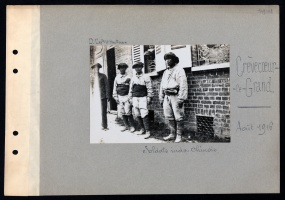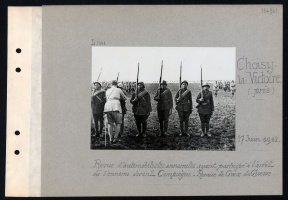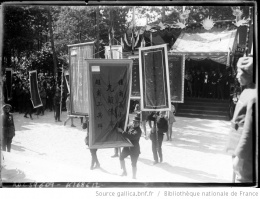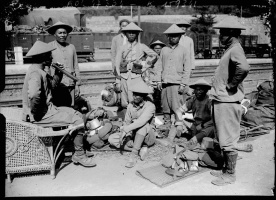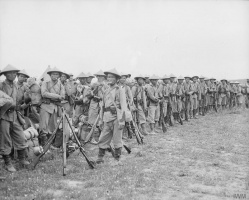Indochina at War↑
On the eve of the Great War, Indochina was a vast and diverse French colonial ensemble. It was comprised of multiple territories, featuring different statuses and forms of rule: Tonkin, Annam, Cochinchina (which constitute present-day Vietnam) as well as Cambodia and Laos. In 1911, General Théophile Pennequin (1849-1916) coined the idea of a so-called “Yellow Army” for France, an Asian force that, like the plan for African forces championed by General Charles Mangin (1866-1925) a year prior (the famous “Black Army” or force noire), would help bolster France’s demographic and military position in the event of war.[1]
Over the course of the war, approximately 100,000 Indochinese men were recruited, roughly half as workers, the other half as soldiers. Official military statistics from 1924 reveal that 48,922 troops were raised in Indochina, of whom 1,548 perished or were unaccounted for at the war’s end.[2] Large recruitment campaigns began in 1915, as the war bogged down on the Western Front. As Mireille Le Van Ho has noted, recruitment propaganda grew more sophisticated in Indochina as the war progressed, especially by 1917.[3] By then, a wide range of methods was being utilized to step up the pace of recruitment including: mobile cinema units, theatre troupes and posters.[4]
Men were motivated to join up by a range of considerations such as patriotism (to the crown of Annam or that of Cambodia, or to France), coercion, socioeconomic pressures in the wake of massive floods in Tonkin and the professional opportunities enlistment presented. Collaborating with the colonial authorities, the imperial court in Hué offered 200 francs to volunteers who passed the physical test; as Kimloan Vu-Hill contends, money was usually a prime motivator.[5] Roughly 80 percent of recruits came from rural areas.[6] Upon recruitment, both soldiers and workers were subjected to a medical exam and an entrance test.[7] Both groups were subsumed under the same administrative structure: the newly created contrôle général des travailleurs et des tirailleurs indochinois (control board for Indochinese workers and soldiers). Some Indochinese forces reached France by way of Madagascar where recruitment was also taking place as the inhabitants of the island had been deemed suitable for combat based on French racial hierarchies.
Within these same colonial hierarchies, Indochinese troops often suffered from negative stereotypes within French military circles and the French high command tended, initially at least, to direct them towards logistical rather than combat roles.[8] Kimloan Vu-Hill describes the work of these soldiers as follows: “They transported troops from one battlefield to another, filled bomb craters, fixed railroad tracks, and worked to keep munitions and food supplies flowing.”[9] Others served as nurses and automobile or truck drivers.[10] Among the Indochinese troops that did fight on the front line, some participated in combat at the Chemin des Dames in 1917, others at the Vosges, Verdun and the Somme. Others still, like the First Batallion of Indochinese Tirailleurs, were deployed to Salonika in 1917.
By war’s end, many Indochinese soldiers and workers languished or were utterly disillusioned with both the conditions in France and the strict encadrement, or controls, to which they were subjected (with respect to pay, mobility, postal censorship). Many veterans were involved in revolt and insurrection in the years after their return to Indochina.
The Temple du Souvenir Indochinois↑
Indochinese losses were commemorated in Annam, Cochinchina, Tonkin, Cambodia and Laos, to be sure, but also in the colonial metropole. Daniel Sherman has underscored tensions between local, regional and national imperatives and forms in French memorials, not to mention disputes about how monuments would be funded.[11] Similar tensions were at work in Indochina, complicated by colonial dynamics.
In December 1917, Souvenir Indochinois (literally “Indochinese Memory”) was founded in France as a subsidiary organization to the vaster Souvenir Français. Its goal was to commemorate Indochinese sacrifice in the Great War. In January 1918, the organization reviewed a series of possible models for a large memorial. The projected monumental ensemble would be located in the Bois de Vincennes in Nogent-sur-Marne, just outside of Paris. The site was significant for several reasons. It housed a tropical garden, a jardin colonial, akin to Britain’s Kew Gardens, and thus, to the project’s conceivers, seemed a logical site for the memorial. Many colonial soldiers, including but not exclusively Vietnamese ones, had been treated in Nogent in a makeshift hospital during the war. It had also been the site of a colonial exhibit in 1907 and therefore possessed several pavilions and some colonial artifacts that could be incorporated into the memorial.
Souvenir Indochinois described its objectives as follows in January 1918:
Here was an attempt at syncretism: the creation of a French Republican Pantheon devoted to Indochinese soldiers and workers who died for France, where the rites of commemoration would be performed along indigenous lines (although which of Indochina’s many religions would be represented and who would oversee ceremonies remained sensitive questions). Regardless, Souvenir Indochinois deemed it critical to recognize the “importance which the Indochinese attach to the accomplishment of duties to be paid to the dead.”[13] The colonial reading of the Vietnamese cult of ancestors, and its significance at Nogent, was encapsulated by the head of Souvenir Indochinois, Henri Gourdon (1876-1943). The memorial in Nogent, he explained in 1920, “gives the wandering souls of the small thoughtful men who came to fight, work and die for us the inviolable protection of a temple [...] in keeping with ancestral faith.”[14] The exotic othering of Indochinese commemorative practices – that were in fact being spearheaded even meticulously planned by French authorities – went hand in hand with claims of cultural protection, preservation and the policy of association (indirect rule).
Initially, the governor of Indochina had hoped to manage and operate the memorial ensemble that would soon become known as the Temple du souvenir indochinois (“the Temple of Indochinese Memory”) of Nogent-sur-Marne. But Nogent’s complicated status, coupled with that of the jardin colonial, rendered this impossible. In addition, bickering over costs soon threatened to derail the project. Very quickly, it became apparent that Souvenir Indochinois would require individual donations. Erica Peters has demonstrated that the amount of donations to the cause from Indochina far surpassed initial hopes. Peters articulates two related claims about this wave of donations on the part of Vietnamese people in particular. Firstly she contends that the cause of the Souvenir Indochinois proved evocative and quite popular as a way of “alleviat[ing] the danger of untended, unvisited graves, a motive that made sense to communities and individuals in Vietnam.” Secondly, she adds that one need consider the subversion of colonial power dynamics at work when Vietnamese people contributed to a French cause. This subversion of the colonial order was an empowering gesture in itself.[15] The gesture was in turn also linked to status. For instance, the French colonial archives contain a list of donors who contributed more than 200 francs to the cause. Here, Vietnamese notables, like Trieu-Vang-Truong from the village of Vinh-Loi and the dignitary Nguyen Dang Koa from Sadec rubbed shoulders with the colony’s French elite: the Denis brothers and their retail empire, the members of a Masonic lodge in Saigon, the proprietors of the Mari pharmacy in Saigon and so on.[16] Prestige therefore was certainly a motivation behind some donations. A 1920 article penned by Lê-Quang-Liêm in the Saigon newspaper Echo Annamite called upon "generous notables" from all Indochina to give to the Temple du Souvenir, adding that there would still be time to engrave donors’ names on the temple's lacquered inner wall. Giving a large sum to Souvenir Indochinois thus provided a measure of recognition and immortalization.
The Temple du souvenir indochinois that emerged from this fundraising campaign proved a complex and unwieldy mix: a dinh or communal house erected for an earlier colonial exhibit in Marseille was converted into the main “temple” building, imperial urns from Hué stood meters from Cambodian style bridges. Authorities struggled with questions of identity, pluralism and inclusion. Thus, a 1942 source explained the creation of a separate monument for the dead from Laos and Cambodia at Nogent:
Interestingly, the phnom, or stupa, dedicated in memory of the Laotians and Cambodians at Nogent was conceived by the Frenchman Émile Auberlet, who would go on to participate in the design of the Angkor Wat Temple for the 1931 Vincennes Colonial Exhibition.[18]
The many divisions within Indochina came to the fore at Nogent-sur-Marne. Why had Cambodia and Laos been bunched together, for instance? They were no doubt as culturally different as the lands that would later comprise Vietnam. In that case, why were highland ethnic groups not represented? Regions soon demanded their own memorials: Echo annamite in Saigon complained, "We regret that Cochin-China (modern-day southern Vietnam) was not represented at this inauguration in Nogent. We regret even more that our own temple, the Panthéon of our national glory... has not even gotten off the ground."[19] The question of commemorating Christian Indochinese soldiers particularly preoccupied the officials of Souvenir Indochinois. As Charles Keith has shown, the dinh or the main temple at Nogent was envisioned as a site of ancestor worship, featuring a blend of Buddhism, Confucianism and Taoism. This vision soon elicited fierce resistance from colonial missionaries and Vietnamese Catholics alike. One missionary fumed at the absence of any Catholic ceremony at Nogent. A separate stele was consequently erected for Indochinese Christians “who had died for France.”[20] The Temple du souvenir indochinois might have held some kind of orientalist or even supra-regional coherence to its creators; to others it was tantamount to a reductionist slight that negated the plurality of French Indochina.
The Temple du souvenir indochinois was inaugurated in a lavish ceremony on 9 June 1920. In attendance were Marshal Joseph Joffre (1852-1931), Dang-Ngoc-Oanh, representing the Emperor of Annam, the French Minister of the Colonies Albert Sarraut (1872-1962), as well as President Alexandre Millerand (1859-1943). The pageantry clearly stoked the exotic imagination of the French press. Echo de Paris marveled: “complete silence [...] and then, suddenly, the plaintive cry of the gong [...] Firecrackers explode like machine-guns [...] as the procession moves forward [...] After the strange display of sounds comes one of colours.” The article concluded that this “splendid oriental celebration” had suitably honored “the souls of those little soldiers born under the hot sun and who died by our sides.”[21] Elsewhere in metropolitan France, most notably in Aix-en-Provence, other smaller memorials to Indochinese losses were erected. Aix-en-Provence memorial features an additional plaque to “the Vietnamese who died for France in the war of 1939-1945.”
The Temple du souvenir indochinois was part of a larger commemorative ensemble at Nogent-sur-Marne. A nearby stele honored all black troops that had fought for France and another monument, featuring a royal eagle, commemorated Malagasy losses. In 1984, the dinh burned to the ground (the cause of the fire has never been established) but the other elements of the temple remain today. Since 1954, several veterans’ organizations have tended to assimilate the memory of Indochinese losses in the two world wars into that of the Indochinese War of 1945-1954.
Monuments in Indochina↑
In 1921, the Saigon press was full of debates about the city’s future monument to Indochina’s war dead. Why had Saigon had to wait so long for one, some asked? Others lamented the costs involved in bringing sculptors, like Paul Ducuing (1867-1949), from the metropole all the way to Indochina. Why could one not rely on local talent, asked others? A monument commission was established to resolve these and other vexing issues.[22] On the face of it, such debates echo those analyzed by Daniel Sherman for metropolitan France: the monument mania of the post-war was laced with political tensions surrounding the place of the local, of religion, cost and other considerations. Similarly, in Phnom Penh, the capital of Cambodia, a monument to the dead of the Great War, resting on two sculpted elephants, opened in March 1925 before a vast crowd bringing together “people of all races and all religions.”[23] Many of the World War I monuments in former French Indochina have not survived to the present day. There are exceptions, however, like the 1914-1918 war memorial still standing at Hué, the former imperial capital.
Unsurprisingly, a closer look at commemoration in Indochina reveals additional colonial fractures. During the 11 November 1920 ceremonies in Saigon, “Annamese” and French losses were remembered during separate ceremonies, the former at a pagoda, the latter at the maison des soldats et marins.[24] None other than Ho Chi Minh (1890-1969) focused on the cultural differences surrounding commemoration of the fallen. He lambasted a French newspaper for organizing “splendid celebrations” to honor the fallen, when a more reserved, subdued and respectful tone would have been more in keeping with Vietnamese custom, contended the revolutionary.[25] Commemoration of the Great War had become one of many sources of anti-colonial grievance.
Eric Thomas Jennings, University of Toronto
Section Editor: James P. Daughton
Notes
- ↑ Le Van Ho, Mireille: Le Général Pennequin et le projet d’armée jaune, 1911–1915. Revue française d’histoire d’outre-mer 279 (1988), pp. 145-167.
- ↑ Vu-Hill, Kimloan: Coolies into rebels: Impact of the World War I on French Indochina, Paris 2011, p. 51 and 71. The 1924 figures come from Le Van Ho, Mireille: Mémoires d’outre-mer: les colonies et la Première Guerre mondiale, Peronne 1996, p. 107.
- ↑ Le Van Ho, Mireille: L’Indochine. In: Mémoires d’outre-mer 1996, p. 81.
- ↑ Rives, Maurice and Deroo, Eric: Les Linh Tap: Histoire des Militaires indochinois au service de la France, 1859-1960, Paris 1999, p. 55.
- ↑ Vu-Hill, Kimloan: Sacrifices, sex, race: Vietnamese experiences in the First World War, in: Das, Santanu (ed.): Race, Empire and First World War Writing. Cambridge 2011, p. 55 and 58.
- ↑ Rives and Deroo, Les Linh Tap 1999, p. 65.
- ↑ Vu-Hill, Kimloan: Coolies into rebels: Impact of the World War I on French Indochina, Paris 2011, p. 53.
- ↑ Rives and Deroo, Les Linh Tap 1999, p. 55.
- ↑ Vu-Hill, Sacrifices, sex, race” in Das (ed.), Race, Empire and First World War Writing 2011, p. 77.
- ↑ Rives and Deroo, Les Linh Tap 1999, p. 58.
- ↑ Sherman, Daniel: The Construction of Memory in Interwar France. Chicago 1999.
- ↑ Archives nationales d’outre-mer, Aix-en-Provence (ANOM) GGI 33413.
- ↑ Ibid.
- ↑ Henri Gourdon, quoted in: La consécration du Temple aux mânes des Indo-Chinois morts pour la France. In: Le Petit parisien, 10 June 1920.
- ↑ Peters, Erica: "Negotiating Power through Everyday Practices in French Vietnam, 1880-1924" PhD thesis, University of Chicago 2000, p. 313.
- ↑ ANOM GGI 33413.
- ↑ L’Oeuvre du Souvenir Indochinois. Paris 1942, p. 2.
- ↑ Lévêque, Isabelle: Un lieu de mémoire. In: Lévête, Isabelle / Pinon, Dominique / Griffon, Michel (eds.): Le jardin d’agronomie tropicale: de l’agriculture coloniale au développement durable, Arles 2005, p. 120.
- ↑ "La prochaine inauguration du Temple du Souvenir à Nogent-sur-Marne" L'Echo annamite, 13 August 1920, p. 1.
- ↑ Keith, Charles: Catholic Vietnam: A Church from Empire to Nation, Berkeley 2012, p. 184.
- ↑ Faure-Biguet, J. N.: La Consécration d’un temple annamite. In: L’Echo de Paris, 10 June 1920.
- ↑ La Commission du monument aux morts. In: Affiches saïgonnaises, 23 September 1921, p. 3.
- ↑ Inauguration à Pnom-Penh du Monument aux Morts du Cambodge. In: Extrême-Asie, March 1925, p. 36.
- ↑ Programme. In: Affiches saïgonnaises, 29 October 1920, pp. 7-8.
- ↑ Ho, Chi Minh: Oeuvres choisies. Paris 1967, pp. 52-53.
Selected Bibliography
- Aldrich, Robert: Vestiges of the colonial empire in France. Monuments, museums, and colonial memories, New York 2005: Palgrave Macmillan.
- Fogarty, Richard: Race and war in France. Colonial subjects in the French army, 1914-1918, Baltimore 2008: Johns Hopkins University Press.
- Gunn, Geoffrey: Coercion and co-optation of Indochinese worker-soldiers in World War I. Mort pour la France, in: Social Scientist 42/7-8, 2014, pp. 63-84.
- Hill, Kimloan: Sacrifices, sex, race. Vietnamese experiences in the First World War, in: Das, Santanu (ed.): Race, empire and First World War writing, Cambridge; New York 2011: Cambridge University Press.
- Ho, Mireille Le Van: Le général Pennequin et le projet d'armée jaune (1911-1915), in: Revue française d'histoire d'outre-mer 75/279, 1988, pp. 145-167, doi:10.3406/outre.1988.2658.
- Jennings, Eric Thomas: Remembering 'other' losses. The Temple du Souvenir Indochinois of Nogent-sur-Marne, in: History & Memory 15/1, 2003, pp. 5-48.
- Keith, Charles: Catholic Vietnam. A church from empire to nation, Berkeley 2012: University of California Press.
- Le Van Ho, Mireille: L’Indochine: Mémoires d'outre-mer. Les colonies et la première guerre mondiale, Péronne Cédex 1996: Historial de la Grande Guerre, pp. 80-89.
- Lévêque, Isabelle: Un lieu de mémoire: Le jardin d'agronomie tropicale. De l'agriculture coloniale au développement durable, Arles 2005: Actes Sud, pp. 113-125.
- Rives, Maurice / Deroo, Eric: Les Linh tâp. Histoire des militaires indochinois au service de la France, 1859-1960, Panazol 1999: Lavauzelle.
- Vu-Hill, Kimloan: Coolies into rebels. Impact of World War I on French Indochina, Paris 2011: Les Indes savantes.





